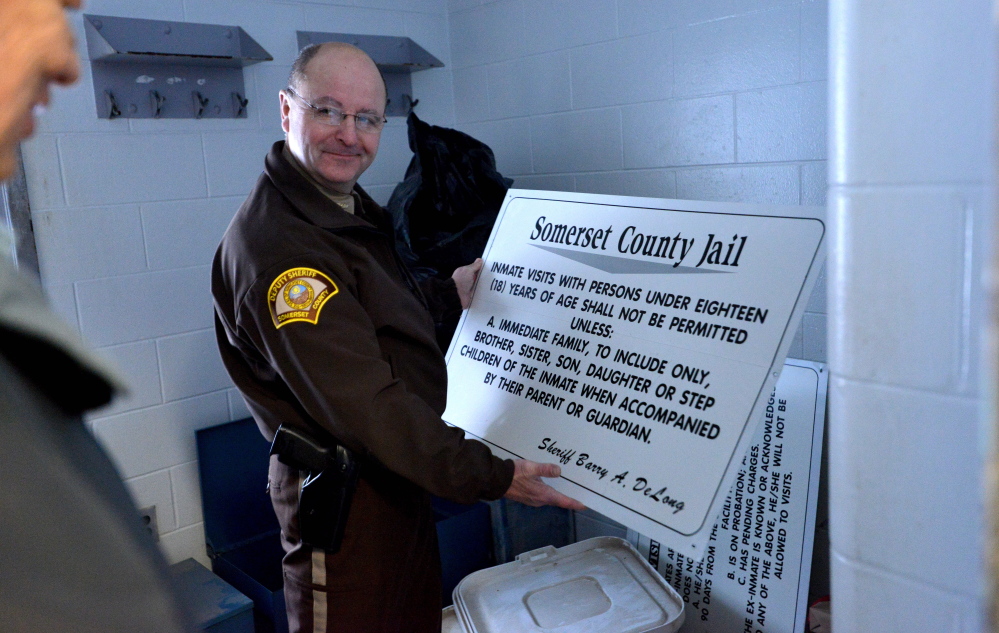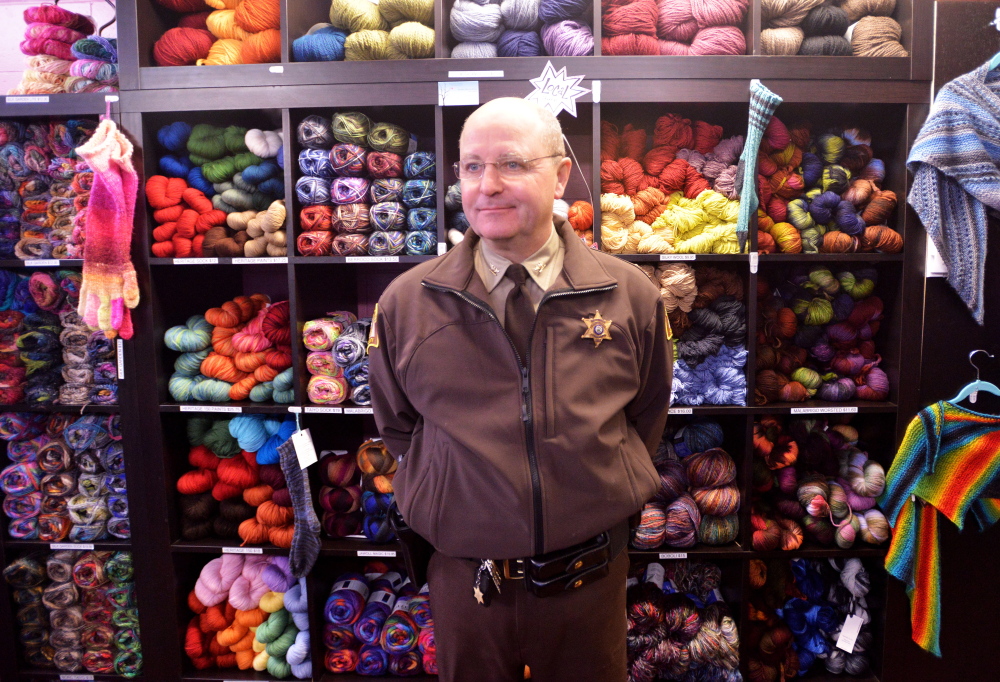SKOWHEGAN — Retiring Somerset County Sheriff Barry DeLong stood against a backdrop of brightly colored yarn in what was once the visiting room at the former county jail.
Now, it’s a downtown hub of artisan businesses.
DeLong, elected sheriff in 1993, remembered well the place where inmates met with visitors, with its painted cinder block walls, heavy metal tables bolted to the floor and bars on the windows.
Inmates and visitors would try to smuggle drugs, tobacco and other contraband in the room.
“Pretty near everything went on in this room,” DeLong, 66, said during a recent tour of the former Somerset County Jail, which closed in 2009. “There was no contact — they’d be allowed to hold hands, but you know things became very hard to control here. It was all open and there was a lot of people in here with just a table separating them — it’s like you see on TV in the old jails — ‘no contact’ becomes contact.”
The room — remodeled, repainted and refurnished — is now home to Happy Knits, a yarn shop run by four area women inside what is now the Somerset Grist Mill and six other spin-off businesses in the old jail. Amber Lambke is the building’s owner and Grist Mill founder.
DeLong is retiring after 20 years as county sheriff and a total of 40 years in law enforcement, including 20 with Maine State Police. His chief deputy, Dale Lancaster, was elected sheriff in November and takes over in January.
Neither DeLong nor Lancaster had ever seen how much has been done to the old building, and they marvel at its new life.
“What would have become of this building?” Lancaster said. “It would have become dilapidated and it would have been torn down. Look at the people she (Lambke) employs now — 20 people in six or seven small businesses.”
Lambke, of Skowhegan, and her business partner Michael Stoltz, a baker and wheat farmer from Albion, purchased the jail from the county in 2009 for about $75,000. They converted it into a working grist mill, with other businesses and community supported agriculture programs.
Since then, about $1.5 million has been invested in the property.
“I had no idea when I bought the building, the power of a project — any kind of project — to really mobilize people behind an idea that inspires hopefulness and action,” Lambke said. “I never dreamed that we’d have this many businesses in here or it would be as successful as it is and I know my initial goal was to find a place to set up the mill operation, but in many respects, all the extra stuff secured the business plan if the mill didn’t work out.”
TOURING THE OLD JAIL
During the recent tour of the old jail, which was built in 1895, Lambke showed DeLong and Lancaster what has taken place inside the former hoosegow in recent years.
DeLong and Lancaster toured the Pickup Cafe and multi-farm CSA, which on a recent Wednesday served up 112 shares of garden vegetables. When it was a jail, the space housed an area that had a dirt floor and was surrounded with high jail house fences.
The razor wire is gone and the jail inmates were moved in 2009 to a new $32 million county jail in East Madison.
During the tour of the kitchen at the Pickup Cafe, DeLong remembered meals being served through a window into the cafeteria where inmates sat and ate together.
“The inmates were all brought down, not like the new jail where they eat in their cell, they were all brought down a cell at a time,” he said. “You’d bring down 15, 20 inmates, which created a real problem because sometimes they’d fight coming down, fight going up, fight while they we’re having their dinners and you had to hand-count everyone in, everyone out.”
A small room that once served as the office for the jail administrator — and before that the jail coal room — is now an occasional Pop Up Shop. An antique dealer has rented one of the old cell blocks, as has a local arts group for a community radio station that looks out onto the Skowhegan Farmers’ Market in the old jail house parking lot. A consultant has visited to see if it’s possible to use some of the space to age cheese.
The former jail control room is now the Tech Spot where high school students give lessons to older residents on how to use computers and navigate the Internet. A tight corridor with sliding medal doors that now houses Lambke’s office, a break room, a locker room and storage, was the section of the jail that housed female inmates, DeLong said.
“The females sometimes were worse than the males,” he said. “From here I could see issues, problems, happening pretty quickly — a female trying to meet with a male or vice versa and quite often they’d get hollering and that gets the men excited and the males would start creating a lot of problems for the employees, again, like you see on TV.”
A NEW LIFE
And then there is the building’s centerpiece — a grist mill — built on four levels in what was once the jail’s cafeteria and cell blocks, still with bars on the windows and inmate graffiti scratched into the protective Plexiglas. This year the grist mill will have processed and marketed 250 tons of whole wheat grain and oats to markets all over New England and down to New York City.
The tour went from the kitchen to what was once the fenced-in recreation area for the inmates. Now it’s a courtyard with tables and chairs and a wood-burning outdoor oven for making pizza.
Iver Lofving, who is renting the Pop Up Shop Dec. 9-13, said he is amazed at what has become of the old jail. He said he and his wife had a foster child that had spent some time at the jail.
“It was interesting to come back here to see how this became an incubator for all these businesses,” Lofving said. “It’s unbelievable — it has worked way beyond their wildest dreams. The farmers are here and I think it’s a wonderful transformation and it’s part of what has brought Skowhegan back.”
Lambke said she became interested in her trade because Somerset County was once a major producer of grain. She said the railroad stopped coming to Skowhegan around 1955 — there was a passenger terminal and freight yard near the jail — and that’s when the last of local grist mills went out of business. Lambke said her dream to return grain production to Somerset County was realized with the jail, which still had inmates in it during her first tours.
“Officer Giggey, the jail administrator, would always holler, ‘There’s a female on deck,'” Lambke said of her first three or four tours of the jail. “We got caught in the kitchen one time during meal time and they had to lock everything down.”
The granite and stone walls of the old jail were thick and the multiple floors ideal for sending material up and down from the receiving area to the milling and cleaning equipment, and back down to the shipping room. It was perfect, she said.
DeLong said he was most impressed during the tour with how the new owners managed to cut through thick floors, ceilings and walls to move machinery into place to create the grist milling and processing area.
“This was the general population area of the jail — with all the holes cut you can hardly recognize it,” DeLong said. “There’d be like 20 inmates here and 20 more on the next floor in two blocks. Maximum population was about 42, but we were given a variance of 55 and we held as high as 100.
“It’s pretty amazing what they’ve done here — I’m amazed especially with the cutting of the walls, that must have been quite a project. Unbelievable.”
Walking over to one of the windows in the mill room — still with the Plexiglas, the graffiti and the iron bars — DeLong recalled how jail inmates would stand at the window and try to communicate with people in the municipal parking lot, an activity discouraged by jail employees.
DeLong and Lancaster finished their tour with Lambke still asking questions about using space at the old jail.
“It was fun,” DeLong said after the tour. “And I will come back and have brunch and supper here at the Pickup.”
Doug Harlow — 612-2367
Twitter: @Doug_Harlow
Send questions/comments to the editors.










